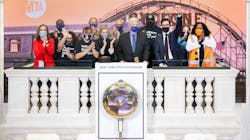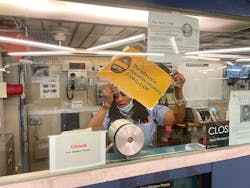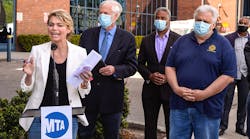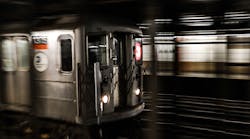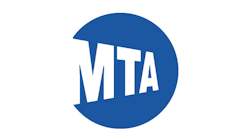UPDATED: MTA returns to 24-hour service with largest officer presence in the past quarter century
One key facet of New York City returned on May 17, marking a striking milestone as the U.S. and the city look to further progress into recovery mode from the COVID-19 pandemic: 24-hour subway service.
For the first time since May 6, 2020, Metropolitan Transportation Authority (MTA) put away its “subway closed” signs that had been hanging four hours per night until Feb. 22, when it extended service two hours.
To celebrate the return of subway service, MTA leadership and frontline workers rang the New York Stock Exchange opening bell on May 17.
Interim New York City President Sarah Feinberg said, “The transit system is really a mirror of the city’s vitality, and since New York City is the city that never sleeps, it needs a subway to match; so, obviously this is a very proud day for us. I want to thank the incredible transit workforce and the rest of the MTA workforce for everything they’ve done to get us to this point. And I want to give a shout out to all the heroic essential workers from across MTA and across the city, who it is our great honor to serve; they are truly our heroes.”
The subway reopening wasn’t the only good piece of news for MTA and riders. The authority announced it had achieved a new record in pandemic ridership with more than 2.26 million trips taken on the subway, more than 104,000 Long Island Rail Road trips taken and more than 85,500 trips taken on Metro-North Railroad on May 14. MTA explains these figures mark the highest single-day ridership totals for those agencies since the start of the COVID-19 pandemic for both commuter railroads and the subway system.
To support its momentum and continue to promote increased transit use, the MTA launched its #TakeTheTrain, #TakeTheBus marketing and communications campaign. MTA says the campaign “encourages New Yorkers to return to a more reliable, cleaner system than the one many last used before the pandemic arrived in New York.”
MTA cites recent surveys that found 72 percent of customers describe trains as being cleaner than they were before the pandemic. MTA has implemented rigorous disinfecting and cleaning efforts, tested ultraviolet light disinfecting and air purification technology and distributed millions of masks through its system to mitigate the spread of the COVID-19 virus.
“Thanks to our unprecedented cleaning efforts, trains and buses are cleaner than they have ever been before,” said Feinberg. “And customers are noticing.”
City says it will deploy additional officers
In addition to more riders and the new marketing campaign, MTA customers may also notice more badged officers on stations and trains.
New York City Mayor Bill de Blasio announced on May 17 the New York City Police Department (NYPD) would deploy an additional 250 officers to the subway, which will join the 2,500 NYPD Transit officers in the subway and the additional 500 auxiliary police officers the city deployed to the 20 busiest subway stations following a series of attacks on MTA employees in early May.
Mayor de Blasio told a press briefing on Monday “public safety is crucial to the recovery; recovery supports public safety, they go together.”
The mayor said the increased deployment will bring the total number of officers patrolling the network to approximately 3,250, which the mayor said was the largest NYPD transit force in more than 25 years.
However, he strongly encouraged MTA to “step up” and fill open officer vacancies. The mayor said the city would train the new officers for free.
MTA is actively hiring. At the April meeting of the MTA Board, MTA Chief of Police Joe McGrann reported the hiring of 48 recruits the morning of the meeting, which brought the force of transit officers to 953 with a goal of growing to 1,300 in total.
Transport Workers Union Local 100 President Tony Utano called the additional officers “a big win.”
“There’s more to be done but this is a significant step forward. Workers and riders have a right to work and ride in safety,” said Utano.
MTA Chief Communications Officer Abbey Collins issued a statement asking for the mayor to clarify "the real number of officers being dedicated" to patrolling the subways saying the claim of deploying an additional 250 officers wasn't additional at all.
“In February, the mayor first announced a surge of 644 officers into the system, and then dozens of auxiliary officers dedicated to the 20 busiest stations, and then an additional 80 new officers from the NYPD academy dedicated to the Transit Bureau," said Collins. "Today, he announced an 'additional' 250 officers being specially deployed to the subways. That total should come to more than 1,000 officers. Now it turns out 20 percent of those 644 have already been withdrawn, as we have previously raised concerns about, and the 250 announced today aren’t new officers at all, but just extra shifts and will not even be full time. This is irresponsible. The mayor should immediately clarify for the public and our employees once and for all the real number of officers being dedicated to the safety of the subway system.”
--------------------
Story updated 5/18/2021 to incorporate statement from Abbey Collins.

Mischa Wanek-Libman | Group Editorial Director
Mischa Wanek-Libman is director of communications with Transdev North America. She has more than 20 years of experience working in the transportation industry covering construction projects, engineering challenges, transit and rail operations and best practices.
Wanek-Libman has held top editorial positions at freight rail and public transportation business-to-business publications including as editor-in-chief and editorial director of Mass Transit from 2018-2024. She has been recognized for editorial excellence through her individual work, as well as for collaborative content.
She is an active member of the American Public Transportation Association's Marketing and Communications Committee and served 14 years as a Board Observer on the National Railroad Construction and Maintenance Association (NRC) Board of Directors.
She is a graduate of Drake University in Des Moines, Iowa, where she earned a Bachelor of Arts degree in Journalism and Mass Communication.
